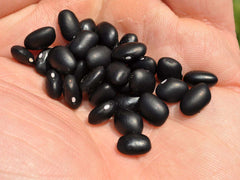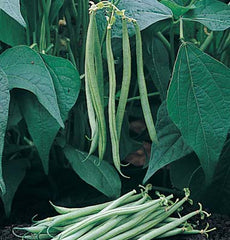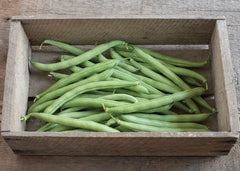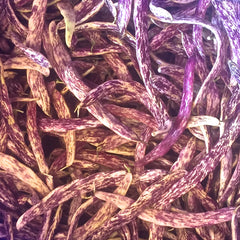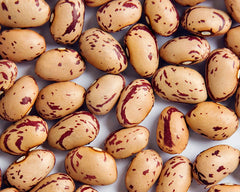Trout
Phaseolus vulgaris
HOW TO GROW BEAN
Direct sow after last frost when soil tempt is about 70˚F. Beans are sensitive to cool soil and will rot if soil temps are below 55˚F. Sow bush snap beans every 2-3 weeks until mid summer for a continued harvest. Sow pole beans from late spring to very early summer. Sow pole beans 3 seeds per hole, 8” between hole and trellis rows 4’ spacing. Thin to 6-8” apart. Beans are susceptible to numerous diseases, avoid wetting foliage, remove plants at the end of the year, practice 4 year crop rotation. Save each year’s seeds in separate containers. Crossing is not apparent until the next generations. Soil pH 6-6.8. Hardiness zones 5-13. Annual.
Days from maturity calculated from the date of seeding. Average 30-65 seeds per ounce. Average 116M (bush) 46M (pole) seeds per acre. Federal germination standard: 70%. Usual seed life: 4 years. Isolation distance for seed saving: 1/2 mile.
Planting Depth 1-2”
Soil Temp. Germ. 70-95˚F
Days to Germ. 3-7
Plant Spacing 2-3”
Row Spacing 18-36”
Days To Maturity 107
Full Sun, Moist Well Drained
Days from maturity calculated from the date of seeding. Average 30-65 seeds per ounce. Average 116M (bush) 46M (pole) seeds per acre. Federal germination standard: 70%. Usual seed life: 4 years. Isolation distance for seed saving: 1/2 mile.
Planting Depth 1-2”
Soil Temp. Germ. 70-95˚F
Days to Germ. 3-7
Plant Spacing 2-3”
Row Spacing 18-36”
Days To Maturity 107
Full Sun, Moist Well Drained
- 50 Seeds$4.10
- 1/4 lb$12.50
This plump kidney type shelling bean has a striking speckled maroon and ivory coloring. The dry beans have a fruity, nutty, and rich flavor, and are dense and meaty in texture. They hold their shape well when cooked for a long time in stews or soups. Trout beans are also know by the name Jacob’s Cattle or Appaloosa....
This plump kidney type shelling bean has a striking speckled maroon and ivory coloring. The dry beans have a fruity, nutty, and rich flavor, and are dense and meaty in texture. They hold their shape well when cooked for a long time in stews or soups. Trout beans are also know by the name Jacob’s Cattle or Appaloosa. Originally the this variety was cultivates in the northeast United States and southeastern Canada. The Passamaquoddy indigenous people of Maine grew these beans as a staple food. Tags: Type: Bush, Harvest: Late, Color: Bi-Colored, Heritage: Heirloom, Season: Summer, Certification: Organic.
Learn More
Meet Your Farmer
We promote fair trade, organic practices and environmental responsibility throughout the Restoration Seeds supply chain. Below are the family farmers and seed suppliers who bring our open pollinated seeds to you.
Madrona Seeds
Certified Organic by Oregon Tilth
Seed grower since 2017


Maddie, Jess, and little Soma live in the North Quabbin region of Massachusetts. There they grow food and seed for their community using beneficial and regenerative practices. They are motivated to participate in the resiliency of the earth through the act of tending the soil and seed saving. Through workshops, events, and a CSA program, we strive to create opportunities for people to experience and connect with food and seed in a healthy way.
Reviews
